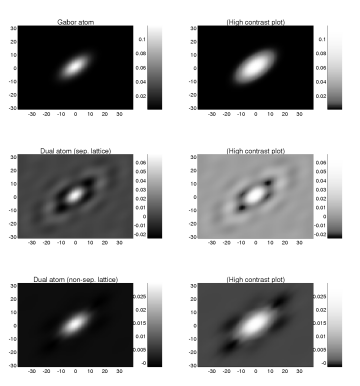I used P. Prinz’ toolbox to compute a 2D dual atom on a separable lattice and on a quincunx lattice. It shows that even if both lattices have same redundancy, the dual might be better localized on the quincunx lattice:

In this example, the norm difference of the “quincunx dual” to the original is about 0.1, and that between the “separable dual” and the original is almost 1.0. To achieve more similarity on the separable lattice, one has to take a higher redundancy.
I’m still not sure what the term “separability” actually expresses for 4D lattices: There exist position lattices (on the image space), frequency lattices (on the FT space), and TF-lattices (for both dimensions). If the atom is separable into its two dimensions, then one can compute the two 1D duals and obtain the 2D dual from their tensor product. If one takes two quincunxes for computing those two 1D duals, does this correspond to a non-separable 4D PF-lattice? In the case of 1D signals, a separable TF-lattice means that there’s always the same set of frequencies taken at every position. A quincunx lattice means that there are two different sets of frequencies chosen alternately while walking along the position points. Maybe the same interpretation works for the 2D case. I haven’t analyzed Prinz’ routine yet, but I think that he takes a rectangular (separable) frequency lattice and shifts it alternately by a half of the lattice-point distance while walking along the position spots. Should one try to use a quincunx position lattice? Well, I’ll have to experminent with that.
HGFei asked me to contact Søndergaard, because that topic of non-separability is currently not only “hot” for myself.